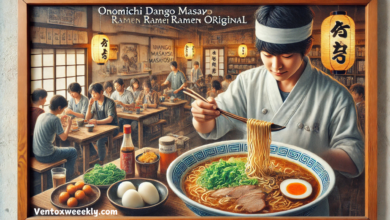Molho Vermelho Concentrado Coreano: A Deep Dive into Korean Red Pepper Paste (Gochujang)

Molho vermelho concentrado coreano (Korean red pepper paste), or gochujang, is a vibrant and multifaceted condiment that has carved a unique place in the culinary world. A cornerstone of Korean cuisine, gochujang combines heat, sweetness, and savory umami, adding depth to various dishes from Korea and beyond. Explore this essential Korean ingredient’s origins, preparation, health benefits, and versatile uses and understand why it has garnered a global following.
What is Molho Vermelho Concentrado Coreano (Gochujang)?
Gochujang is a thick, fermented paste made from red chili powder, glutinous rice, fermented soybeans, and salt. Every component is essential to producing a spicy and subtly sweet paste. Gochujang’s unique flavor results from the meticulous fermentation process, which often takes several months to mature fully.
Key Ingredients of Gochujang:
- Red Chili Powder (Gochugaru): Provides heat and vibrant red color.
- Glutinous Rice: Adds sweetness and texture to balance the spiciness.
- Fermented Soybeans: Contributes umami and savory notes, enhancing the depth of flavor.
- Salt: Acts as a preservative and intensifies the taste.
Origins and Cultural Significance of Gochujang
The roots of gochujang trace back to the 16th century when chili peppers were first introduced to Korea. Over generations, Koreans developed unique fermentation processes, which were eventually recognized as an important cultural heritage. Today, gochujang holds both culinary value and cultural significance, symbolizing patience and tradition in Korean households. Generations have passed down preparation techniques and recipes, with many families creating large batches that last for months.
Traditional and Modern Production Methods
The traditional preparation method involves fermenting the gochujang paste in earthenware pots called onggi. These pots allow the paste to “breathe” and ferment naturally under Korea’s changing seasonal conditions, resulting in a rich, complex flavor. The fermentation typically lasts three to six months, with some artisanal gochujang batches aged for even longer.
With rising global demand, large-scale production methods have emerged, offering a faster but quality-controlled approach to fermentation. While some brands still adhere to traditional methods, others employ controlled fermentation techniques to meet consumer needs without compromising flavor.
Health Benefits of Molho Vermelho Concentrado Coreano
- Rich in Nutrients: Gochujang contains essential vitamins and minerals, including vitamins B and C, iron, and potassium. These nutrients support general well-being and health.
- Probiotics for Gut Health: Like many fermented foods, gochujang contains beneficial bacteria that can improve digestion and boost immune function.
- Anti-Inflammatory Properties: Chili peppers’ main ingredient, capsaicin, is well-known for its anti-inflammatory and metabolism-boosting effects. Frequent use can help with weight control and reduce inflammation.
- Aids in Metabolism: Capsaicin also helps boost metabolism, which can benefit those looking to manage weight through diet.
Culinary Uses of Gochujang
Gochujang’s versatility has made it a staple in Korean cuisine and fusion dishes worldwide. Here are some popular ways to incorporate it into your culinary repertoire:
Traditional Korean Dishes
- Bibimbap: Bibimbap is a mixed rice meal with meat, veggies, and a fried egg on top. It is often finished with a dollop of gochujang, a paste that adds the perfect spice and umami, harmonizing all the ingredients.
- Tteokbokki: This street food favorite features chewy rice cakes in a thick gochujang-based sauce. It is often combined with fish cakes and vegetables. Tteokbokki is beloved for its satisfying texture and spicy kick.
- Dakgalbi: This spicy stir-fried chicken dish is marinated in a gochujang-based sauce, which adds heat and sweetness. It is a popular choice for gatherings and celebrations.
International and Fusion Dishes
- Gochujang Marinade for Meats: Use gochujang as a marinade for grilled or roasted meats, especially chicken or pork, to add a unique Korean twist to barbecues and dinners.
- Spicy Korean-Inspired Tacos: For a fusion experience, marinate your taco meat with gochujang and serve with traditional taco toppings. The gochujang’s tart and sweet components elevate the dish.
- Spaghetti Sauce: Add a spoonful of gochujang to your tomato-based pasta sauce for an extra kick of spice and umami.
Everyday Cooking Uses
- Dipping Sauce: Mix gochujang with soy sauce, vinegar, and a touch of sugar for a quick and flavorful dipping sauce for dumplings or spring rolls.
- Stir-Fry Enhancer: Add a small amount to your stir-fry sauces for a Korean-inspired flavor profile.
- Soups and Stews: A small spoonful adds a depth of flavor and a slight heat that pairs well with hearty ingredients.
How to Make Molho Vermelho Concentrado Coreano at Home
Making gochujang at home requires patience but can be incredibly rewarding. Here’s a simplified version for home cooks:
Ingredients:
- 1 cup red chili powder (gochugaru)
- ½ cup glutinous rice flour
- 2 cups water
- ½ cup fermented soybean powder
- ½ cup salt
- ½ cup malt syrup or sweetener
Instructions:
- Mix glutinous rice flour and water, then cook on low heat until thick.
- Add the soybean powder, salt, and malt syrup to the mixture.
- Stir in the red chili powder and mix thoroughly.
- Transfer the paste to a container or an earthenware pot, covering it loosely.
- Let the paste ferment in a cool, dark place for at least one to three months.
Homemade gochujang can last several months if kept in an airtight container in the refrigerator.
Where to Buy and How to Store Gochujang
Gochujang is widely available in Asian grocery stores and online retailers. When purchasing, look for reputable brands that use authentic ingredients and traditional fermentation methods for the best quality. The paste is generally available in mild, medium, and hot spice levels, allowing you to choose according to your preference.
After opening, store gochujang in the refrigerator in a tightly sealed jar to maintain flavor and freshness. For long-term storage, you can freeze portions in ice cube trays, making it easy to use just the right amount whenever needed.
Tips for Cooking with Gochujang
- Start Small: Gochujang is potent, so start with a small amount and adjust to taste.
- Balance Flavors: Pair gochujang with sweeteners like honey or brown sugar to mellow the spice or with acidic ingredients like vinegar for a tangy contrast.
- Experiment in Fusion Dishes: Don’t be afraid to use gochujang in non-Korean recipes. It pairs well with various flavors, making it An excellent complement to salads, marinades, and sauces.
Conclusion
Molho vermelho concentrado coreano, or gochujang, is a unique ingredient that combines Korean cuisine’s depth and complexity into any dish. From its historical roots to its versatile culinary uses, gochujang offers various flavors for home cooks and chefs alike. Whether preparing a traditional Korean meal or experimenting with fusion cuisine, gochujang adds a bold, unforgettable taste to elevate your cooking.



